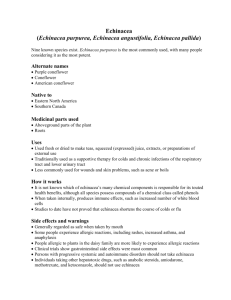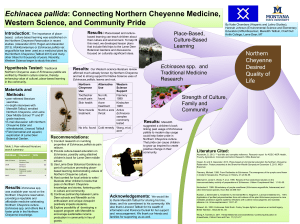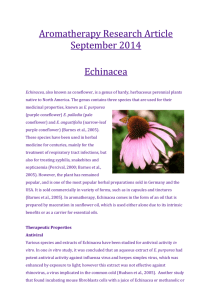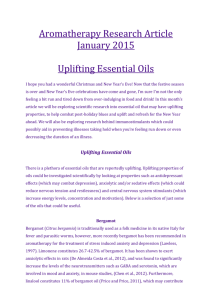Medicinal Herbs
advertisement
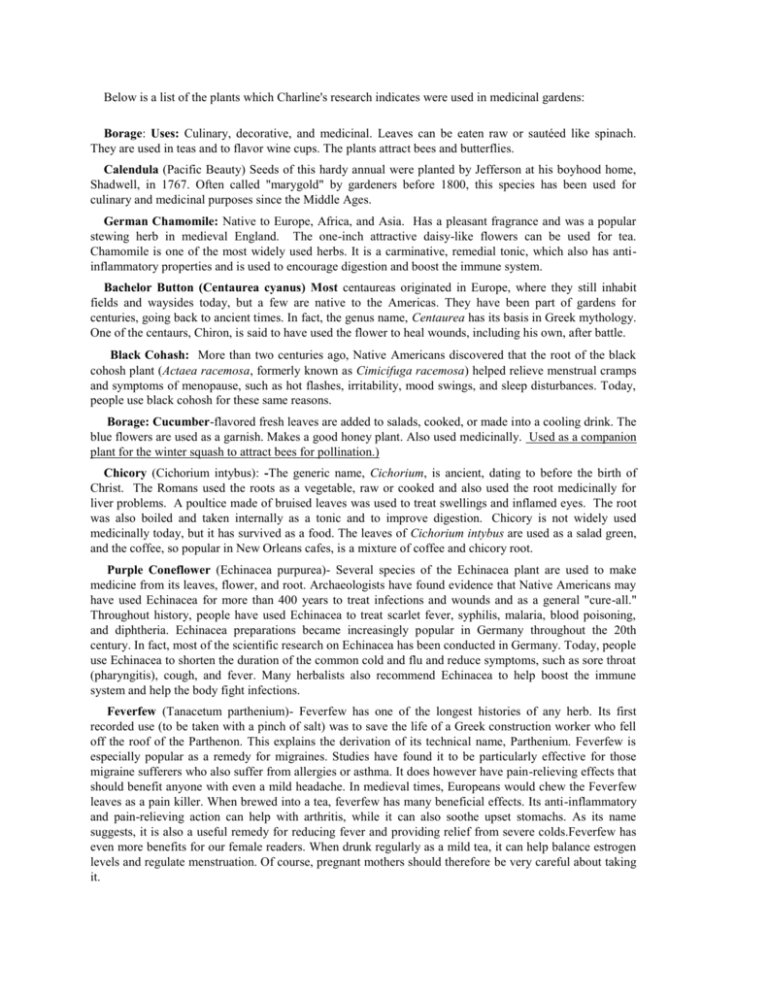
Below is a list of the plants which Charline's research indicates were used in medicinal gardens: Borage: Uses: Culinary, decorative, and medicinal. Leaves can be eaten raw or sautéed like spinach. They are used in teas and to flavor wine cups. The plants attract bees and butterflies. Calendula (Pacific Beauty) Seeds of this hardy annual were planted by Jefferson at his boyhood home, Shadwell, in 1767. Often called "marygold" by gardeners before 1800, this species has been used for culinary and medicinal purposes since the Middle Ages. German Chamomile: Native to Europe, Africa, and Asia. Has a pleasant fragrance and was a popular stewing herb in medieval England. The one-inch attractive daisy-like flowers can be used for tea. Chamomile is one of the most widely used herbs. It is a carminative, remedial tonic, which also has antiinflammatory properties and is used to encourage digestion and boost the immune system. Bachelor Button (Centaurea cyanus) Most centaureas originated in Europe, where they still inhabit fields and waysides today, but a few are native to the Americas. They have been part of gardens for centuries, going back to ancient times. In fact, the genus name, Centaurea has its basis in Greek mythology. One of the centaurs, Chiron, is said to have used the flower to heal wounds, including his own, after battle. Black Cohash: More than two centuries ago, Native Americans discovered that the root of the black cohosh plant (Actaea racemosa, formerly known as Cimicifuga racemosa) helped relieve menstrual cramps and symptoms of menopause, such as hot flashes, irritability, mood swings, and sleep disturbances. Today, people use black cohosh for these same reasons. Borage: Cucumber-flavored fresh leaves are added to salads, cooked, or made into a cooling drink. The blue flowers are used as a garnish. Makes a good honey plant. Also used medicinally. Used as a companion plant for the winter squash to attract bees for pollination.) Chicory (Cichorium intybus): -The generic name, Cichorium, is ancient, dating to before the birth of Christ. The Romans used the roots as a vegetable, raw or cooked and also used the root medicinally for liver problems. A poultice made of bruised leaves was used to treat swellings and inflamed eyes. The root was also boiled and taken internally as a tonic and to improve digestion. Chicory is not widely used medicinally today, but it has survived as a food. The leaves of Cichorium intybus are used as a salad green, and the coffee, so popular in New Orleans cafes, is a mixture of coffee and chicory root. Purple Coneflower (Echinacea purpurea)- Several species of the Echinacea plant are used to make medicine from its leaves, flower, and root. Archaeologists have found evidence that Native Americans may have used Echinacea for more than 400 years to treat infections and wounds and as a general "cure-all." Throughout history, people have used Echinacea to treat scarlet fever, syphilis, malaria, blood poisoning, and diphtheria. Echinacea preparations became increasingly popular in Germany throughout the 20th century. In fact, most of the scientific research on Echinacea has been conducted in Germany. Today, people use Echinacea to shorten the duration of the common cold and flu and reduce symptoms, such as sore throat (pharyngitis), cough, and fever. Many herbalists also recommend Echinacea to help boost the immune system and help the body fight infections. Feverfew (Tanacetum parthenium)- Feverfew has one of the longest histories of any herb. Its first recorded use (to be taken with a pinch of salt) was to save the life of a Greek construction worker who fell off the roof of the Parthenon. This explains the derivation of its technical name, Parthenium. Feverfew is especially popular as a remedy for migraines. Studies have found it to be particularly effective for those migraine sufferers who also suffer from allergies or asthma. It does however have pain-relieving effects that should benefit anyone with even a mild headache. In medieval times, Europeans would chew the Feverfew leaves as a pain killer. When brewed into a tea, feverfew has many beneficial effects. Its anti-inflammatory and pain-relieving action can help with arthritis, while it can also soothe upset stomachs. As its name suggests, it is also a useful remedy for reducing fever and providing relief from severe colds.Feverfew has even more benefits for our female readers. When drunk regularly as a mild tea, it can help balance estrogen levels and regulate menstruation. Of course, pregnant mothers should therefore be very careful about taking it. Hyssop (Hyssopus officinalis): Hyssop is a name of Greek origin. The Hyssopos of Dioscorides was named from azob (a holy herb), because it was used for cleaning sacred places. It is alluded to in the Scriptures: 'Purge me with Hyssop, and I shall be clean.’ Is used as an expectorant, diaphoretic, stimulant, and pectoral, carminative. The healing virtues of the plant are due to a particular volatile oil. A tea made with the fresh green tops, and drunk several times daily, is one of the old-fashioned country remedies for rheumatism that is still employed. Hyssop baths have also been recommended as part of the cure, but the quantity used would need to be considerable. English Lavender (Lavandula angustifolia): Thomas Jefferson included “lavender” in a 1794 list of “objects for the garden this year.” Lavender is one of the most well known of the traditional aromatic herbs, and used since at least the 12th century. In Jefferson's time, Lavender water for the bath was popular, and Mary Randolph gave "receipts" for Lavender water in The Virginia Housewife, 1824. She also recommended preparing a "cosmetic soap for washing hands" using oil of Lavender. The flowers attract bees and butterflies. This plant is deer and drought tolerant. Golden Marguerite "Kelways" (Anthemis tinctoria)- Another common name for Golden Marguerite is Dyer's Chamomile, which hints at the plant's herbal use. The flowers can produce a yellow dye, and the plant is sometimes cultivated for the dye. The plant has also been used medicinally; when rubbed onto the skin its leaves can relieve the sting of insect bites. Oxlip (Primula Elatior): In modern herbal medicine, the infusion of the root is generally taken in tablespoonful doses as a good remedy against nervous headaches. A teaspoonful of the powdered dry root serves as an emetic. St. John's Wort (Hypericum perforatum) has a history of being used as a medicine dating back to ancient Greece, where it was used for a range of illnesses, including various "nervous disorders, has antibacterial and antiviral properties applied to the skin to help heal wounds and burns. Scullclap(Scutellaria lateriflora) Skullcap is well known among the Cherokee and other Native American tribes, as emmenagogue and medicinal herb for females. It is used in some tribes as a ceremonial plant to induct young girls into womanhood. Soapwort (Saponaria ocymoides): The common name, 'Bouncing bet, is an abbreviated form of 'bouncing Betty', an old-fashioned term for a washerwoman used medicinally for a wide variety of ailments: skin problems such as poison ivy rashes and dermatitis, leprosy, venereal diseases, liver ailments, cough, and kidney stones. Yarrow (Achillea millefolium) Legend has it that yarrow (Achillea millefolium) was named after Achilles, the Greek mythical hero who used it to stop the bleeding wounds of his soldiers. Popular in European folk medicine, yarrow contains flavonoids, plant-based chemicals that increase saliva and stomach acid, helping to improve digestion. Yarrow may also relax smooth muscle in the intestine and uterus, which can relieve stomach and menstrual cramps.

